Shichifukujin Seven Lucky Gods
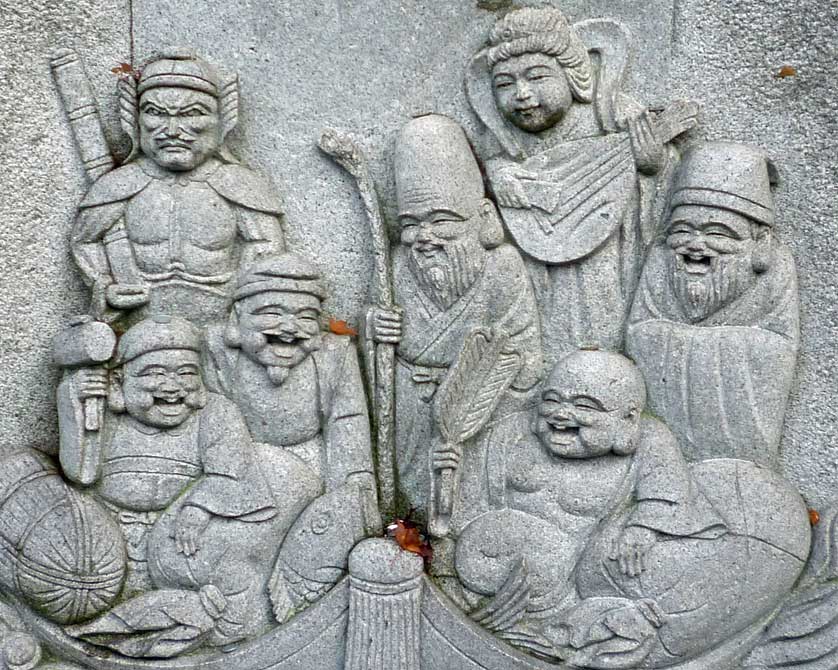
Shichifukujin - the Seven Lucky Gods of Japan
The Shichifukujin, or Seven Lucky Gods, are a beloved group of deities in Japanese mythology and culture. Originating from diverse religious backgrounds including Shinto, Buddhism, and Hinduism, these seven gods are believed to bring good fortune and blessings to their worshippers. Each deity represents different virtues and aspects of prosperity, making them an integral part of Japanese spiritual beliefs and traditions. From ancient times to the present day, the Shichifukujin have played a significant role in art, folklore, and daily life in Japan, offering hope and inspiration to people seeking luck and success.
Origins and historical development of the Seven Lucky Gods
The concept of the Seven Lucky Gods, or Shichifukujin, emerged during Japan's Muromachi Era (1336-1573). This grouping reflects Japan's syncretic approach to religion, blending elements from various belief systems. Initially, the gods were worshipped separately, but they gradually came to be viewed as a collective:
- Three deities originated from India's Hindu-Buddhist pantheon
- Three came from China's Taoist-Buddhist traditions
- One deity, Ebisu, is native to Japan's Shinto tradition
The popularity of the Seven Lucky Gods grew significantly during the Edo period (1603-1867), when they became a common subject in art and literature. The priest Tenkai, advisor to Shogun Tokugawa Ieyasu, is often credited with formalizing the group, associating each god with a specific virtue of an ideal statesman. This connection to governance and prosperity helped cement the Shichifukujin's importance in Japanese culture.
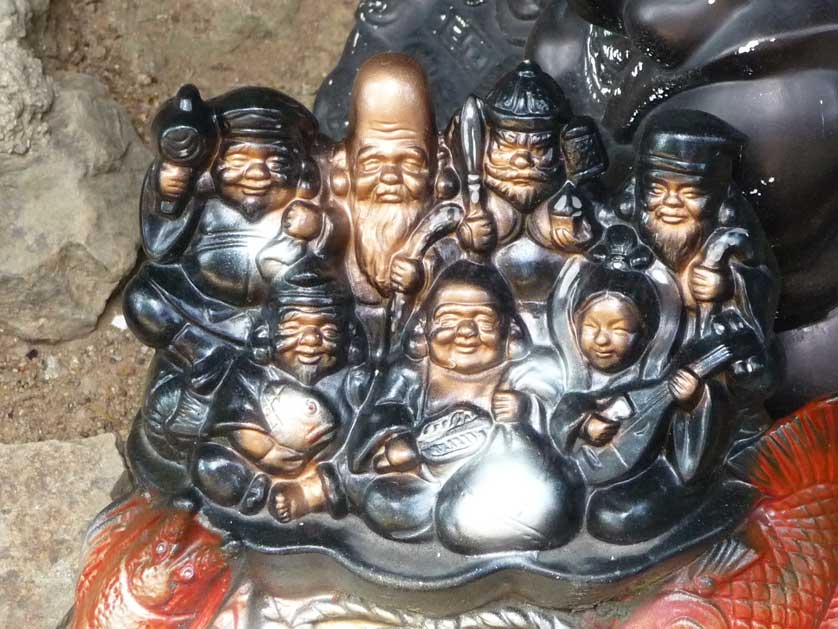
From street corners, to temples, outside businesses and private houses, look out for clusters of ancient characters these are the Seven Lucky Gods.
Individual profiles of the Shichifukujin
Each of the Seven Lucky Gods has unique characteristics and domains:
1. Ebisu (恵比須): The god of prosperity and wealth in business, Ebisu is the only deity of purely Japanese origin. Often depicted as a fisherman, he is the patron of those in the fishing and food industries. Ebisu represents the virtue of honest labor and is associated with Japanese Spiritual Beliefs.
2. Daikokuten (大黒天): Originally from India, Daikokuten is the god of wealth, commerce, and agriculture. He is often shown carrying a magic mallet and a bag of treasures, symbolizing abundance. Daikokuten is popular among farmers and merchants.
3. Benzaiten (弁財天): The only female deity among the seven, Benzaiten originated from the Hindu goddess Saraswati. She is the goddess of knowledge, art, and beauty. Musicians, artists, and geisha often seek her blessings.
4. Bishamonten (毘沙門天): Known as the god of warriors and protector against evil, Bishamonten is depicted in armor, holding a spear and a pagoda. He represents dignity and authority.
5. Fukurokuju (福禄寿): With Chinese origins, Fukurokuju is the god of wisdom, luck, longevity, wealth, and happiness. He is recognizable by his elongated forehead and is often associated with scholarly pursuits.
6. Jurojin (寿老人): Another god of longevity, Jurojin is closely related to Fukurokuju. He is depicted as an old man with a long beard, often accompanied by a deer, symbolizing long life.
7. Hotei (布袋): Known as the Laughing Buddha, Hotei represents contentment and happiness. He is depicted as a jolly, rotund monk carrying a large sack, symbolizing abundance and good fortune.
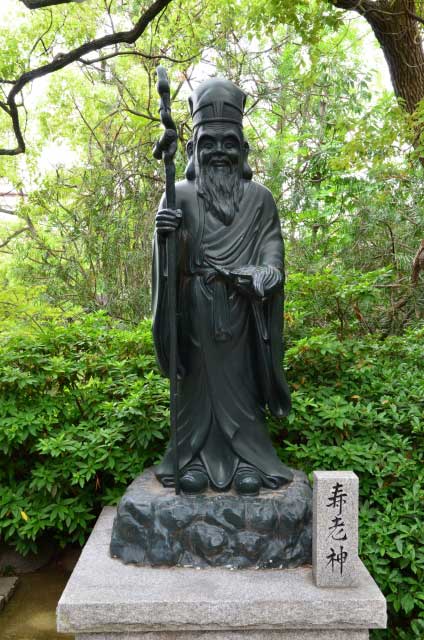
Jurojin, god of longevity
Symbolism and attributes associated with each deity
Each of the Seven Lucky Gods is associated with specific symbols and attributes that represent their domains and powers:
Ebisu: Often portrayed holding a fishing rod and a large red sea bream (tai), symbolizing good fortune and prosperity. His fishing rod represents his ability to "catch" good luck for his devotees.
Daikokuten: Carries a magic mallet called uchide no kozuchi, which can grant wishes. He stands on rice bales, symbolizing abundance, and is often accompanied by mice, representing prosperity.
Benzaiten: Usually depicted playing a biwa (a traditional Japanese lute), representing her connection to the arts. She is sometimes shown with a white snake, symbolizing wisdom and good fortune.
Bishamonten: Holds a spear in one hand and a small pagoda in the other. The spear represents his role as a protector, while the pagoda symbolizes the treasure house of Buddhism.
Fukurokuju: Recognized by his extremely high forehead, symbolizing great wisdom. He often carries a staff with a scroll attached, representing knowledge and longevity.
Jurojin: Similar to Fukurokuju, he is depicted as an old man with a long beard. He is often accompanied by a deer and a crane, both symbols of longevity in Japanese culture.
Hotei: Known for his large belly and jovial expression. He carries a cloth sack (nunobukuro) filled with treasures, which he distributes to those in need.
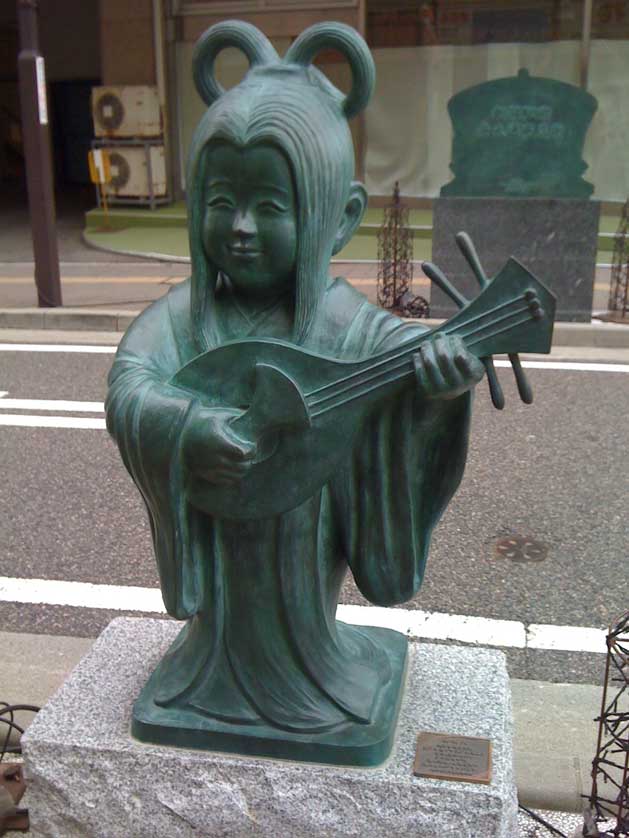
Benzaiten's origins are as a water goddess in India. This member of the seven gods, also known as Benten-sama, is revered in Japan as representing beauty, wisdom and the arts.
The Takarabune (Treasure Ship) and New Year traditions
The Takarabune, or Treasure Ship, is a central element in the mythology of the Seven Lucky Gods. According to tradition, the gods sail into harbor on New Year's Eve aboard this magical vessel, bringing good fortune for the coming year. This concept has given rise to several New Year customs:
- Placing a picture of the Takarabune under one's pillow on the night of January 1st is believed to bring good dreams and fortune for the year ahead.
- Many Japanese households display images or figurines of the Seven Lucky Gods on their Takarabune during the New Year period.
- The Takarabune is often depicted laden with various treasures, including the nunobukuro (lucky bag), an inexhaustible purse, and a magical mallet.
These traditions highlight the importance of the Seven Lucky Gods in Japanese New Year celebrations, symbolizing hope and prosperity for the coming year. The Takarabune has become a popular motif in Japanese art, especially in ukiyo-e prints and decorative objects.

Commemorated in ceramic and metal, statues of the Seven Lucky Gods reveal the superstitious side of the Japanese population. Amulets, talisman, and even mobile phone 'charms' indicate a willingness to rely on the gods for good luck.
Influence on Japanese art, culture, and daily life
The Seven Lucky Gods have had a profound impact on Japanese art, culture, and daily life:
Art and Crafts: The Shichifukujin are popular subjects in various art forms, including:
- Ukiyo-e prints, where they are often depicted in humorous or everyday situations
- Netsuke (miniature sculptures) and other decorative objects
- Contemporary art and manga, where they are sometimes reimagined in modern contexts
Architecture: Many Shinto shrines and Buddhist temples throughout Japan are dedicated to one or more of the Seven Lucky Gods, influencing local architecture and town planning.
Festivals and Customs: Numerous festivals and customs revolve around the Shichifukujin, such as:
- The Shichifukujin Meguri, a pilgrimage to visit temples or shrines associated with each of the seven gods
- New Year traditions involving the Takarabune, as mentioned earlier
- Local festivals honoring specific gods, like the Ebisu Festival in Osaka
Popular Culture: The Seven Lucky Gods appear frequently in Japanese popular culture, including:
- Anime and manga series featuring the gods as characters or themes
- Brand mascots and logos, particularly for businesses seeking to associate themselves with good fortune
- Names of products, restaurants, and even train lines
Their influence extends to daily life, with many Japanese people carrying charms or amulets representing one or more of the Seven Lucky Gods for good fortune.

Beside a road in Abiko, Chiba Prefecture, sits a stone statue of rotund and jovial Hotei, the god of abundance and health.
Popular pilgrimages and shrines dedicated to the Seven Lucky Gods
Pilgrimages to shrines and temples associated with the Seven Lucky Gods, known as Shichifukujin Meguri, are popular throughout Japan. These pilgrimages typically involve visiting seven different sites, each dedicated to one of the gods. Some notable examples include:
1. Yanaka Seven Lucky Gods Pilgrimage (Tokyo): One of the oldest Shichifukujin Meguri in Tokyo, this route takes pilgrims through the historic Yanaka district.
2. Nihonbashi Seven Lucky Gods Pilgrimage (Tokyo): A popular urban pilgrimage route in the heart of Tokyo's business district.
3. Kamakura Seven Lucky Gods Pilgrimage: This route in the ancient capital of Kamakura includes visits to some of the city's most famous temples and shrines.
4. Fushimi Inari Taisha Seven Lucky Gods (Kyoto): While primarily known for its thousands of torii gates, this shrine complex also houses representations of all seven gods.
5. Hiroshima Seven Lucky Gods Pilgrimage: A unique pilgrimage that can be completed by boat, visiting islands in the Seto Inland Sea.
These pilgrimages are especially popular during the first week of January, as many believe completing the circuit will bring good fortune for the entire year. Pilgrims often collect stamps or seal impressions (goshuin) at each site as proof of their visit and as a memento of their journey.
Modern interpretations and relevance of the Shichifukujin in contemporary Japan
In contemporary Japan, the Seven Lucky Gods continue to hold significance, albeit in evolving forms:
Reinterpretations in Popular Media: The Shichifukujin are often reimagined in modern contexts:
- Anime and manga series featuring modernized versions of the gods
- Video games incorporating the gods as characters or themes
- Contemporary art installations offering new perspectives on their symbolism
Tourism and Local Economies: Many cities and towns promote their Shichifukujin connections to boost tourism:
- Creation of new pilgrimage routes or revitalization of old ones
- Special events and festivals centered around the Seven Lucky Gods
- Unique local souvenirs and products featuring the gods
Business and Marketing: The Shichifukujin concept is often used in branding and marketing:
- Company logos and mascots inspired by the gods
- Product lines named after or themed around the Seven Lucky Gods
- Use of Shichifukujin imagery in advertising campaigns, especially around New Year
Cultural Education: The Seven Lucky Gods serve as a tool for teaching about Japan's cultural heritage:
- Educational programs in schools introducing children to these traditional figures
- Cultural events and exhibitions exploring the history and significance of the Shichifukujin
Spiritual and Psychological Relevance: In an increasingly secular society, the Seven Lucky Gods continue to offer:
- A source of hope and positivity, especially during challenging times
- A connection to traditional values and beliefs
- A framework for personal growth, with each god representing a desirable quality or virtue
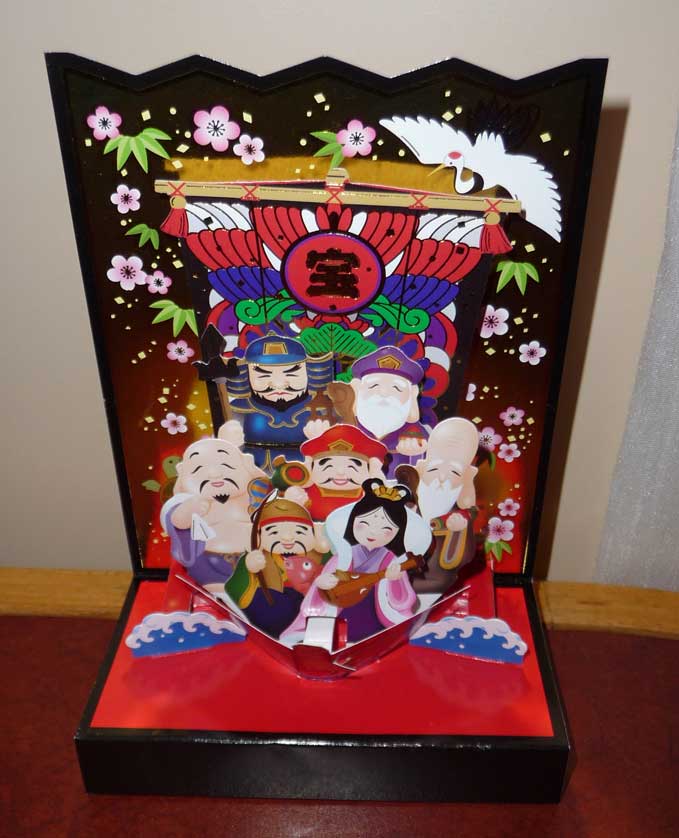
A colourful paper cut-out card pops up to reveal a treasure ship with its passengers - the Seven Lucky Gods.
The enduring popularity of the Shichifukujin in Japan demonstrates their ability to adapt to changing times while maintaining their core essence. They continue to serve as cultural icons, sources of inspiration, and symbols of good fortune in modern Japanese society, bridging the gap between ancient traditions and contemporary life.








